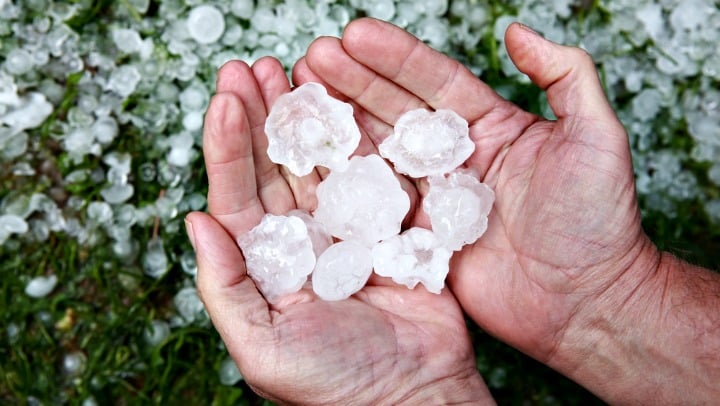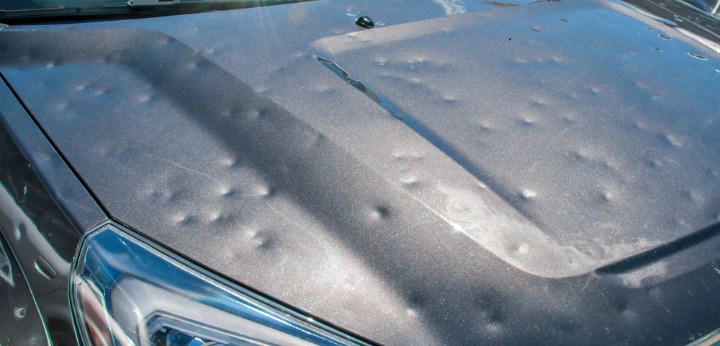Why Hailstorms and Property Damage Are on the Rise

The cost of hail damage in the United States is a growing concern, especially for those who live in Texas, Oklahoma, Colorado, Kansas, Nebraska, and Wyoming — collectively known as “Hail Alley.” Each year, hailstorms cause roughly $10 billion dollars in damage to property across the nation.
But what is hail and how does it develop?
Hail forms when strong currents of rising air, called thunderstorm updrafts, lift droplets of water into the clouds. Hailstones grow as additional water freezes onto it and eventually fall to the ground after it becomes too heavy for the updraft to support it.
To paint a clearer picture of the wide-ranging damage caused by hail, consider: hail the size of a golf ball (1.75 inches) can dent cars; hail the size of a baseball can (2.75) can smash windshields; hail the size of softballs (4.75 inches) can rip through roofs.
In 2017, a hailstorm in Denver caused $2.3 billion alone in insurance losses. Colorado has suffered the lion’s share of damage so far this year, including a hailstorm in June that injured 14 people and killed several zoo animals at Cheyenne Zoo.
It’s no surprise then that 2018 is on target to become the eleventh straight year of $10 billion damage nationwide. With 70% of the $10 billion in annual damage being attributed to hail, weather experts are determined to find out why the cost of hail damage continues to rise.

Increase in hailstorms rally weather experts
An inaugural conference held this past August in Boulder, Colorado, brought together a variety of stakeholders including scientists, weather analysts, and insurance professionals to discuss how efforts to forecast, detect, and mitigate against hailstorms can be improved.
Though experts agreed that climate change is not helping the situation, they also said it is hard to assess its actual role in hailstorms. In a recent InsuranceJournal.com article covering the conference, Andreas Prein, a project scientist at the National Center for Atmospheric Research, said the resulting damage is hard to calculate because hailstorms require distinct ingredients, and global warming affects them in different ways.
This sentiment echoed what experts said at the Second European Hail Workshop, held in Switzerland last year. According to an article published in the America Meteorological Society, a recurring issue discussed in all sessions of the workshop is the lack of reliable, high quality, long-term observational data as well as laboratory experimental data of hail.
Still, Prein believes that that climate change will increase updrafts which help the formation of hailstones. But it will inhibit two-hail producing conditions: Warmer temperatures will expand higher into the atmosphere, so that falling hailstones have more time to melt before hitting the ground and differences in wind speed and direction will subside. And while climate change will make the atmosphere more moist, the effect on hailstones isn’t clear.
What is clear to Prein is that population growth is more of a certainty.
The escalating cost of hailstorms can be traced to three leading factors according to Bryan Wood, a meteorologist and operations analyst for Assurant. In an article he wrote for the Washington Post, Wood says increased residential development in places vulnerable to hailstorms is the greatest factor in rising costs. Why? Because it means more targets for hailstorms to damage.
Wood also attributes larger home sizes. The average size of a home today is 1,000 feet more than the average size of a home back in 1973. This means there is more surface area to be damaged. The invention of vinyl siding, a popular material because of its low-cost appeal, hasn’t helped matters.
The shortage of asphalt shingles — the most popular type of roof cover — is another cause for the rise in cost from hail. Wood says the decrease in asphalt production over the last few decades, along with greater demand for asphalt shingles after storms hit, significantly drive up building material costs.
Homeowners should be proactive against hail
Until science improves enough to better predict hailstorms and evaluate risk, homeowners are at a disadvantage; but not entirely helpless. Awareness on how to prevent additional damage is important.
Inside the home look for:
- Water stains on the ceiling or walls, caused by seepage from the damaged roof
- Cracked or peeling paint, caused by moisture in the walls
- Visible water in the attic, on the beams, insulation or finished areas
- Mold or mildew growth, especially in attics or other dark enclosed areas
- Excessive energy bills, caused by escaping cool or heated air
Don’t forget to hire a roofing company to do an external inspection.
And if you’re inclined to learn from biblical times, you might also want to “get your livestock and all that you have in the field into safe shelter.”
